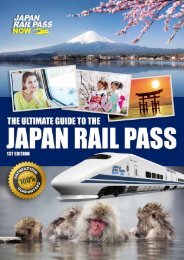Japan Rail Pass Now - Japan Travel Guide
Japan Travel Guide by Japan Rail Pass Now (www.japanrailpass.com.au)
Japan Travel Guide by Japan Rail Pass Now (www.japanrailpass.com.au)
You also want an ePaper? Increase the reach of your titles
YUMPU automatically turns print PDFs into web optimized ePapers that Google loves.
Transportation + <strong>Guide</strong><br />
to <strong>Japan</strong>ese IC Cards<br />
Buses<br />
Buses in <strong>Japan</strong> offer services for both short (within a city) and long distance (between cities) travel.<br />
Local buses<br />
In many of the big cities, buses are commuters’ second choice to trains for transport.<br />
To board a bus, simply look for its designated bus stop and get on through the door at the back. If you have an IC card (a rechargeable transport<br />
card in <strong>Japan</strong>), you just tap it onto the sensor when you enter the bus . If you don’t have an IC card, take a ticket from a box-like machine by<br />
the door as it will be used to determine how much you have to pay for your fare before you get off.<br />
Just like in Australia, once your destination approaches, press a button on the wall to alert the bus driver that your stop is coming up next. If<br />
you have an IC card, tap it onto the sensor next to the driver when you get off. If you don’t have an IC card, have the exact change ready to pay<br />
your fare and drop both it and your ticket into the machine next to the driver.<br />
Highway buses<br />
Highway buses are a cheaper alternative to trains for commuters who don’t mind a longer travel period going from one city or region to another.<br />
In <strong>Japan</strong>, there are several highway bus companies, including:<br />
●<br />
●<br />
●<br />
●<br />
●<br />
<strong>Japan</strong> <strong>Rail</strong>ways (nationwide)<br />
Willer Express (nationwide)<br />
Fujikyu Bus (travel to and from Fuji Five Lakes)<br />
Alpico Express Bus (travel to and from Nagano)<br />
Meitetsu Bus (travel to and from Nagoya)<br />
Usually, reservations are required by phone online, or via travel agents for these buses, especially during holidays and peak seasons. However,<br />
during low seasons, it‘s possible to purchase tickets at the bus stations minutes before departure.<br />
Ferries<br />
Because <strong>Japan</strong> is an archipelago, travelling by ferry from one of its islands to another is a common way to get around. Even though <strong>Japan</strong>’s<br />
major islands — Shikoku, Kyushu, Hokkaido, and Honshu — are linked by numerous airports, railways, tunnels and bridges, there are smaller<br />
islands (e.g. Okinawa and the Daito Islands) that can only be accessed by ferries.<br />
These ferries also carry cargo and smaller vehicles as well as people. They can be small (accommodating about 50 passengers and a few cars)<br />
or large. The larger ferries usually travel longer distances and have more facilities, such as common rooms with tatami mats, a dormitory with<br />
beds, private rooms with 2 to 4 beds, restaurants and public baths.<br />
Rental Cars<br />
In the more rural parts of <strong>Japan</strong>, public transport may be less efficient compared to Tokyo, Osaka and other urban areas. That’s why many<br />
tourists rent a car instead for convenience.<br />
To rent a car in <strong>Japan</strong>, you need to be at least 18 years old and possess an International Driving Permit (IDP) which you must obtain in Australia<br />
before going to <strong>Japan</strong>.<br />
37 - <strong>Japan</strong> <strong>Travel</strong> <strong>Guide</strong>



